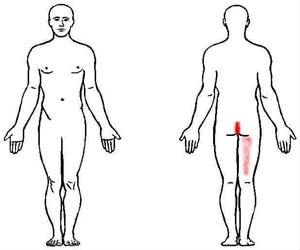
Levator Ani Pain From Trigger Points
Levator Ani Trigger Point

The origin of the levator ani muscle is the inner surface of the side of the lesser pelvis, and the insertion is located on the inner surface of coccyx, levator ani of opposite side, and into structures that penetrate it. The levator ani muscle is innervated by pubococcygeus and iliococcygeus levator ani nerve (S4), inferior rectal nerve from pudendal nerve (S3, S4), coccygeal plexus, puborectalis S3, S4.and levator ani nerve.
The levator ani muscle has a trigger point which is located in the lower torso. The primary symptoms are iliosacral pain, menstrual problems, pelvic pain. The diagram below shows how the referred pain is generated from the coccyx and extends to the back of the thigh, all the way down to the back of the knee.
Conservative Treatments
Therapeutic treatments for addressing soft tissue injuries involve massage therapy, manual therapy, trigger point therapy, Graston Technique, or Active Release Technique. These treatments increase blood flow, decrease muscle spasms, enhance flexibility, speed healing, and promote proper tissue repair.
When these treatments are incorporated into a treatment plan patients heal faster and are less likely to have long-term pain or soft tissue fibrosis or scar tissue in the injured muscle. These soft tissue treatments are incorporated with therapeutic exercise and flexibility programs.
Medical Treatments
NSAIDs are often prescribed for the initial acute injury stages. In severe cases that involve multiple joint regions, muscle relaxers or oral steroids can be given. Trigger point injections, botox, or steroid injections can be treatment options. Pain management is not usually required unless stronger medications or joint injections are required for treatment.
MRI and X-rays will not usually be ordered to evaluate mild to moderate muscle, tendon, and ligament injuries. Severe cases may utilize advanced imaging to rule out bone fractures, edema, nerve entrapments, tendon or muscle ruptures. NCV testing may be utilized in cases that also involve muscle, sensory, or reflex loss.
Sciatica is the term for radiating pain down the leg. Most commonly it comes from the back and radiates down the leg. Several back injuries and nerve entrapment injuries can cause sciatic pain in the leg. The pain patterns from a lumbar disc, lumbar joint sprain, sacroiliac sprain, or piriformis syndrome produces different patterns of radiating pain than trigger points. Proper identification of the pain pattern, along with reproduction of pain from palpation of the trigger point allows the provider and patient to feel comfortable with the diagnosis.
Your chiropractor, physical therapist, occupational therapist, or physician will evaluate your condition and make a proper diagnosis and treatment recommendations. Ask them any questions you might have about your injury.
Conclusion
The lower extremity works as a comprehensive unit performing many of the repetitive tasks at home, work, and recreational sports. Injuries to one area of the musculature often indicate that additional damage has been incurred by other muscles.
Many therapeutic exercises can help restore proper strength and endurance to the leg muscles muscles. Isometric exercises are often the initial treatment exercises. Followed by single plane rubber band exercises for hip, knee, and ankle; flexion, extension, adduction, abduction, circumduction, inversion, and eversion. Dynamic exercises involving stability foam, rubber discs, exercise ball, and BOSU balls can be performed on the floor. The more unstable of the surface the more effort and stabilization is required of all the lower extremity muscles.
Vibration plates enhance neuromuscular learning throughout the ankle, knee, foot, hip, and back muscles. Additional strength exercises can be found on the hip, knee, and foot strengthening pages. More information for injuries and treatments for knee pain and foot pain.
Our Chandler Chiropractic & Physical Therapy clinic treats patients with a variety of muscle, tendon, joint, and ligament injuries. The clinic provides treatment for runners, tri-athletes, and weekend warriors in addition to common headache, neck, and back patients traditionally seen in Chiropractic, Physical Therapy, Massage Therapy clinics. We work with all ages and abilities of the residents in Phoenix, Tempe, Gilbert, Mesa, and Chandler AZ.